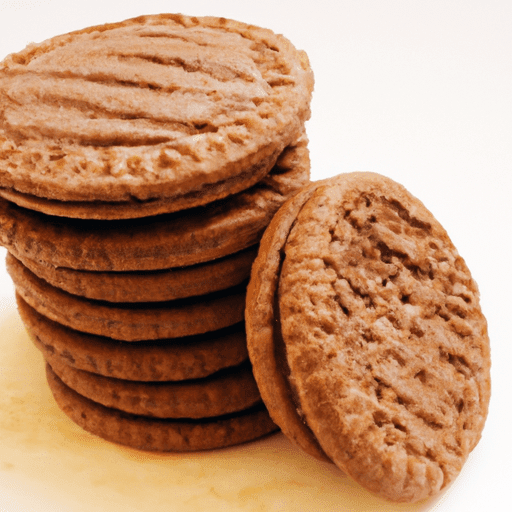The Delicious Delight of Chocolate Digestive Biscuits
When it comes to iconic sweet treats, chocolate digestive biscuits hold a special place in the hearts (and tummies!) of many. With their delightful combination of a buttery biscuit base and a rich layer of chocolate, these delectable delights are a popular choice for both snacking and baking.
Taste and Texture
Chocolate digestive biscuits offer a satisfying crunch, followed by a melt-in-your-mouth moment as the chocolate coating softens. The contrast between the slightly sweet biscuit and the smooth chocolate is simply irresistible. The buttery taste of the biscuit adds a comforting note, making these biscuits perfect for enjoying with a cup of tea or coffee.
Common Uses in Cooking
Aside from being a delicious standalone snack, chocolate digestive biscuits have many versatile uses in the world of cooking and baking. They can be crushed and used as a base for cheesecakes or tart crusts, adding a delightful twist to traditional recipes. Simply combine the finely crushed biscuits with some melted butter, press the mixture into a baking dish, and you have a quick and easy base ready for your favorite dessert.
These biscuits can also be used to create tempting trifles, where they are layered with cream, fruits, and other sweets to form a delectable dessert. Apart from being a key ingredient, they can also be crumbled and sprinkled on top of desserts like ice cream or yogurt for an added texture and burst of chocolatey flavor.
Nutritional Value
While we can all agree that chocolate digestive biscuits are incredibly delicious, it’s important to consider their nutritional value as well. The exact nutritional content may vary between brands, but typically, a serving of chocolate digestive biscuits (usually two biscuits) contain around 160-180 calories, 8-9 grams of fat, and 14-18 grams of sugar. These figures can guide you in incorporating these tasty treats into a balanced diet.
History and Fun Facts
First introduced in the early 20th century, digestive biscuits were originally created to aid digestion, owing to the inclusion of sodium bicarbonate. The addition of chocolate took them to a new level of scrumptiousness. They quickly gained popularity not only in the United Kingdom, their place of origin, but around the world.
Interestingly, the term “digestive” doesn’t refer to any digestive health benefits the biscuits may offer, but rather to the use of baking soda as a key ingredient. Some even believe that the name originated from the thought that these biscuits aided in the digestion of heavier meals. Nevertheless, whatever their origins may be, there’s no denying the timeless appeal of chocolate digestive biscuits.
Conclusion
Chocolate digestive biscuits are a true delight for anyone with a sweet tooth. Their irresistible taste, versatility in cooking, and fascinating history make them a cherished treat enjoyed by many. Whether you’re dunking them in a hot drink or incorporating them into your favorite dessert recipes, chocolate digestive biscuits are sure to bring a smile to your face and warmth to your heart.
Chocolate Digestive Biscuits
Chocolate digestive biscuits are a popular type of biscuit enjoyed in many parts of the world. Here are some interesting facts about chocolate digestive biscuits:
Origin: Chocolate digestive biscuits were first invented in the early 20th century by the British biscuit company McVitie’s. It is said that they were created as a digestive aid due to the inclusion of sodium bicarbonate, which was believed to aid digestion. The addition of chocolate on top was a later variation.
Common Uses: Chocolate digestive biscuits are typically enjoyed as a snack or a treat. They are often eaten on their own, or paired with a cup of tea or coffee. Some people also use them as an ingredient in desserts, such as in cheesecake crusts, ice cream sandwiches, or crushed and used as a topping for puddings.
Nutritional Benefits: While chocolate digestive biscuits are tasty, they are considered to be a high-calorie treat and should be enjoyed in moderation. However, they do provide some nutritional benefits. They are a source of carbohydrates, providing energy, and contain small amounts of dietary fiber. The chocolate coating adds a small amount of iron to the biscuit.
Unique Properties: The distinctive feature of a chocolate digestive biscuit is the combination of a crumbly wheat biscuit base with a smooth layer of chocolate on top. The base biscuit is usually made from wheat flour, wholemeal wheat flour, or a combination of both, along with ingredients like sugar, butter, and baking soda. The chocolate coating is typically made from milk chocolate or plain chocolate.
Historical Significance: Chocolate digestive biscuits have become an iconic part of British cuisine and are widely enjoyed in the United Kingdom. In fact, McVitie’s chocolate digestives are so popular that they are regularly ranked among the top-selling biscuits in the country. They have also gained popularity in other parts of the world, including Australia, South Africa, and India.
Remember to enjoy chocolate digestive biscuits as part of a balanced diet and consider individual dietary needs and preferences.




Use the share button below if you liked it.
It makes me smile, when I see it.